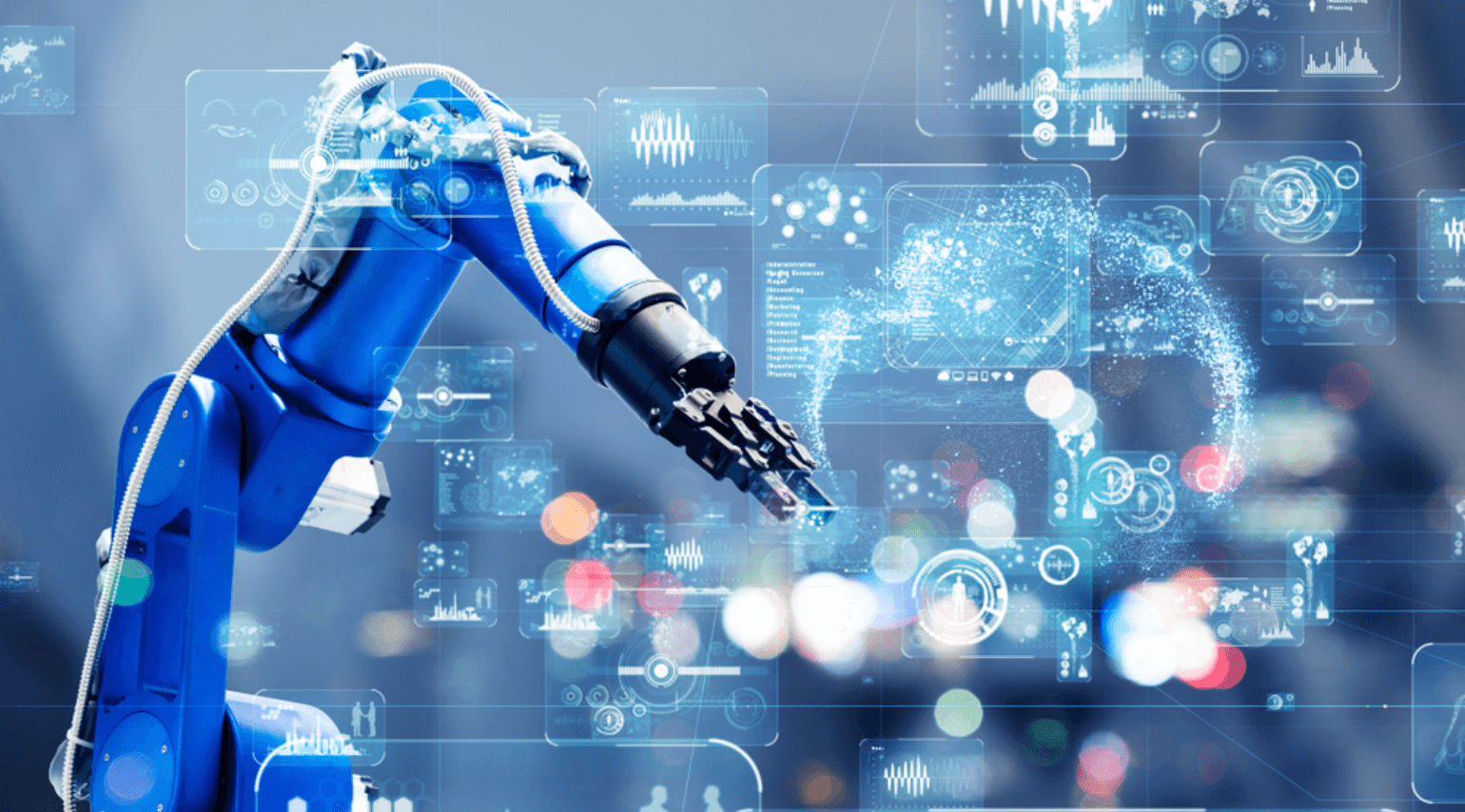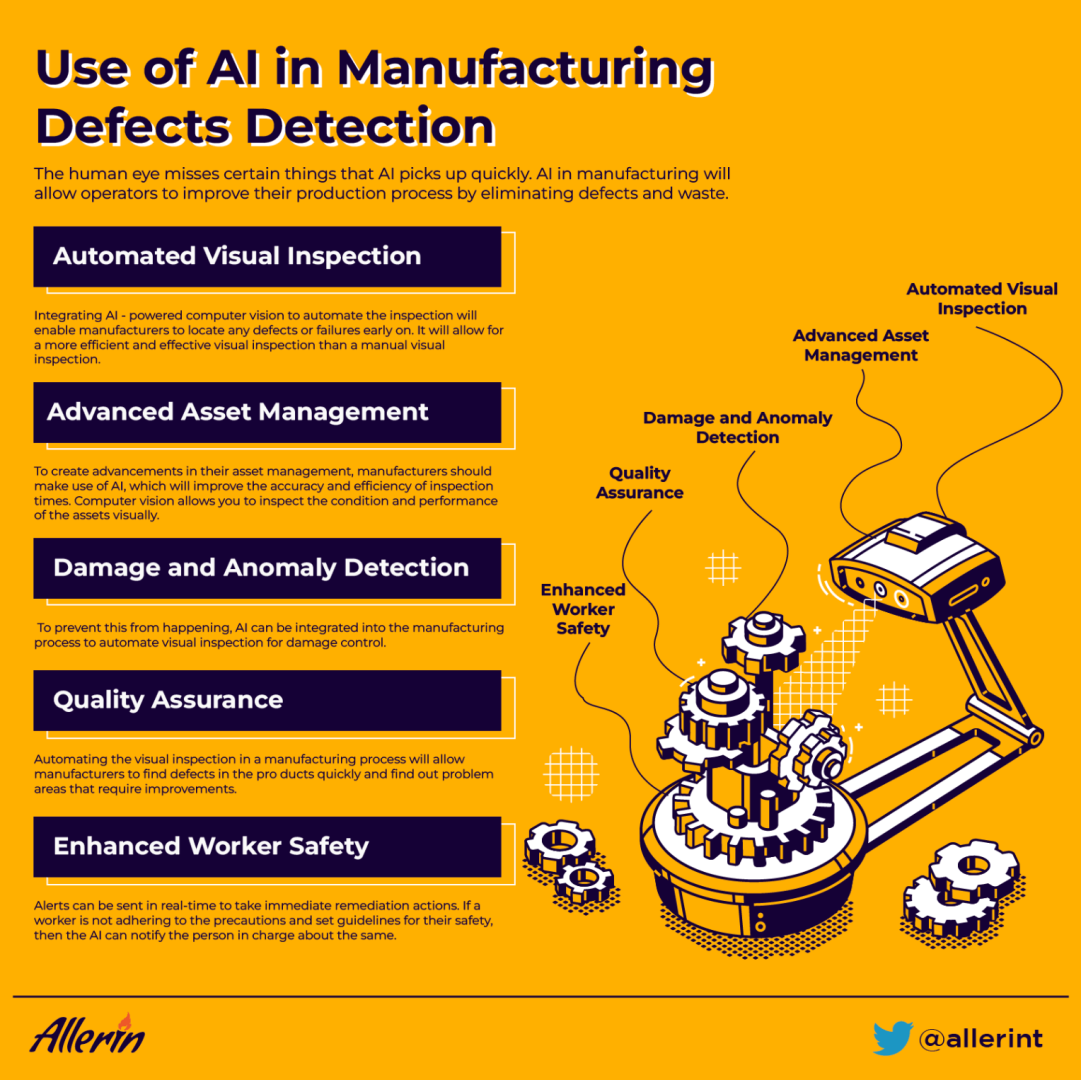Comments
- No comments found

The human eye misses certain things that AI picks up quickly.
AI in manufacturing will allow operators to improve their production process by eliminating defects and waste.
Consumers don’t get to watch how the products they consume are manufactured. However, they can sometimes detect certain defects with adverse impacts. These defects can range anywhere from cosmetic defects on a product to products malfunctioning, which can be quite disastrous. Any such defects can burn a big hole in the pockets of the manufacturer. To reduce or eliminate such defects, AI in manufacturing could be just the solution to revolutionize the industry.
The human eye is sensitive and is not equipped with the technology to be able to see the defects in the manufacturing process. Integrating AI-powered visual inspection will allow the operators to point out errors in the manufacturing process and make their jobs easier. This quickens the entire process and saves time and resources. Due to its enhanced use in eliminating defects and making the process more efficient, the global AI in the manufacturing market is expected to reach $9.8 billion by 2027.
Manufacturers can eliminate defects and errors by integrating proper real-time defect detection on both unknown and anticipated issues in their manufacturing process.
To make the manufacturing process more efficient and economical, AI must be integrated into the manufacturing process using several technologies to detect, inspect and analyze the issues and provide feasible answers to eliminate any anomalies.

It is critical to visually inspect industrial machinery and various other processes in the manufacturing cycle to ensure the safety of products as well as the staff operating the machinery. As of today, there are human visual inspectors who conduct the investigation of the process cycle manually. However, performing the manual inspection is not only time-consuming but also costly for organizations to undertake.
Even though the visual inspectors have created a niche and, through that, gained expertise in the field, one of the main reasons for the increasing cost of human visual inspection is the labor shortage. To provide a product free of defects speedily without decreasing the quality, visual inspection is one of the holds-up for the manufacturing process and various other industries, due to the time taken to do it manually.
Integrating AI-powered computer vision to automate the inspection will enable manufacturers to locate any defects or failures early on. It will allow for a more efficient and effective visual inspection than a manual visual inspection. Backed by computer vision, the assessment of the entire process can enhance operational availability and lower the chances of equipment failure. It will provide manufacturers with more accurate information on improvement areas through a faster speed for processing the defects.
Timely repairs of equipment for any capital-intensive industries, such as airlines, manufacturing, architecture, etc., is a primary tactical result of asset management programs. Quite often, there are hindrances or suspensions of production due to asset downtime. Being able to timely predict production downtime, defective parts and staff issues can create a positive impact on productivity and reduction in costs. It is imperative for organizations to improve the efficiency of their assets. To do so, they need to enhance their approach to maintenance based on usage or time period metrics, such as oils needing to be changed after every 6000 miles traveled, etc.
To create advancements in their asset management, manufacturers should make use of AI, which will improve the accuracy and efficiency of inspection times. Computer vision allows you to inspect the condition and performance of the assets visually. It provides the manufacturer or the supervisor with the opportunity to make a call as to when they want to make capital improvements or take action for maintenance. It also helps improve the average repair time taken, overall equipment effectiveness and adherence to compliance for preventative maintenance. AI-powered maintenance can also notify the correct professional when certain equipment requires manual inspection.
The human eye cannot always keep up with machines. Therefore, having a manual visual inspection of the products manufactured before being delivered to the customer can lead to damaged products being shipped. This will increase the cost and hurt the finances of a manufacturer big time. To prevent this from happening, AI can be integrated into the manufacturing process to automate visual inspection for damage control. Through its image and data processing, AI will be able to locate damages, minor or significant, easily and alert the manufacturers about the same.
At times, there are certain foreign elements such as chemicals or harmful substances that aren’t supposed to be near the manufacturing process. These substances can cause an adverse effect on the entire life cycle of production. AI in manufacturing will be able to detect the same through its computer vision-powered technology and send caution to the organization about the same
Quality assurance is a systematic method to determine whether a service or product meets the stated requirements put forth by the organization. It helps to avoid defects and mistakes in the manufacturing process or products provided to consumers. Quality assurance generally deals with quality checking in the initial stages of a product’s lifecycle to help detect any vulnerabilities to the product before it goes further.
Another essential factor that is evaluated through quality assurance is yield. This helps to understand the number of non-damaged products produced compared to the entire mass produced and gives the operators a ratio of the same. Automating the visual inspection in a manufacturing process will allow manufacturers to find defects in the products quickly and find out problem areas that require improvements. This is especially helpful for quality assurance in the manufacturing of electronics, such as components of a circuit board.
In general manufacturing, it is essential to detect flaws in packaging, labeling, welding, etc. A mislabeled or improper packing or wielding of products can negatively impact the customers and create a costly rectification for the manufacturers. AI-powered visual inspection is beneficial in providing drastic improvements to production quality and efficiency.
Computer vision-enabled visual inspection allows for the detection of any anomalies or vulnerabilities that the workers might be subjected to. Alerts can be sent in real-time to take immediate remediation actions. If a worker is not adhering to the precautions and set guidelines for their safety, then the AI can notify the person in charge about the same. It can also alert the employees if they are in the way of danger without them knowing and take remedial actions quickly. Other than providing improved productivity, it can also help to create a safer work environment for the workers.
In this fast-paced, technology-driven world, manual labor can be seen as a certain hindrance to speedily providing quality products. Human judgments aren’t always accurate in detecting defects in a manufacturing process, and because of this, organizations face certain vulnerabilities. AI in manufacturing is the way forward to help eliminate mistakes, errors and defects in the products manufactured and provided to consumers. It provides not only efficiency and cost-effectiveness but also a safer work environment for all the employees in a manufacturing organization. By automating visual inspection, a manufacturer can quickly get deep insights into the areas of production that needs improvement. Therefore, providing real-time alerts will allow manufacturers to maintain their equipment and provide enhanced customer service through defect-free and quality products.
Naveen is the Founder and CEO of Allerin, a software solutions provider that delivers innovative and agile solutions that enable to automate, inspire and impress. He is a seasoned professional with more than 20 years of experience, with extensive experience in customizing open source products for cost optimizations of large scale IT deployment. He is currently working on Internet of Things solutions with Big Data Analytics. Naveen completed his programming qualifications in various Indian institutes.
Leave your comments
Post comment as a guest